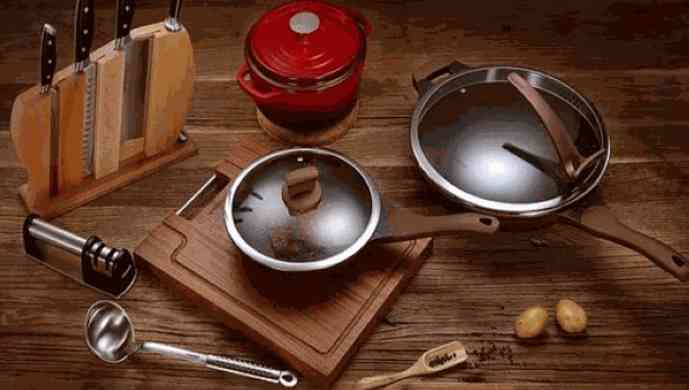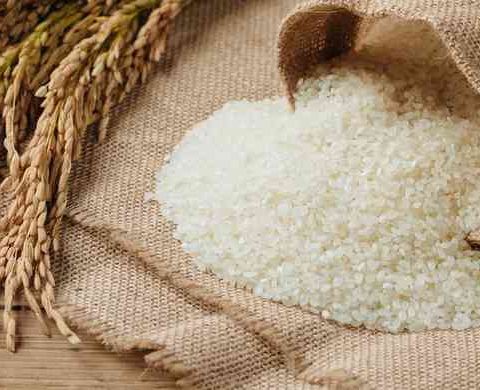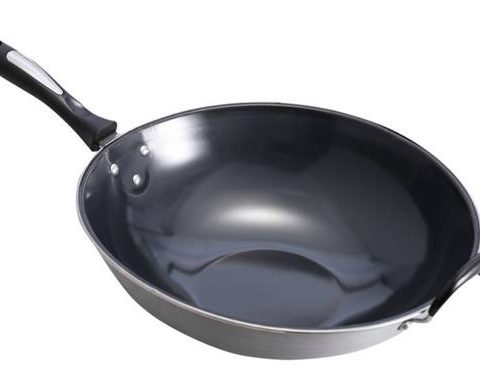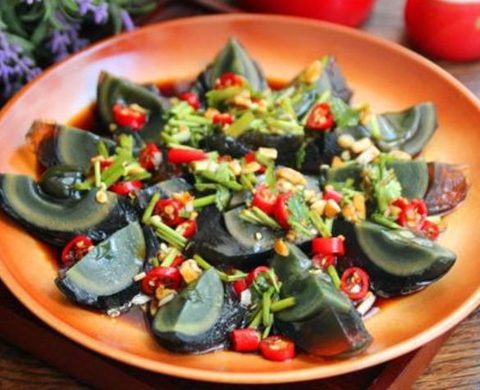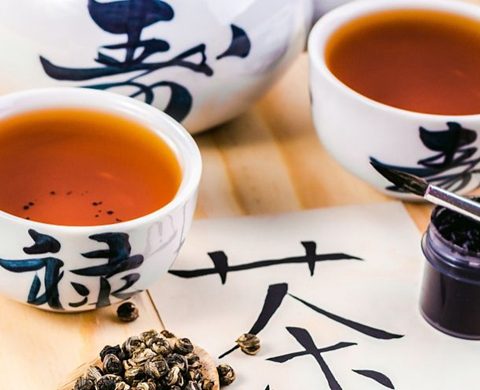1.Cleaver
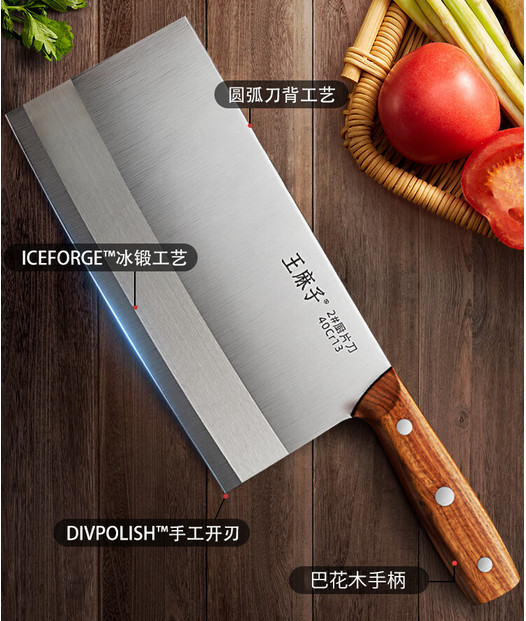
Why do Chinese chefs use cleavers?
The cleaver is a tool for cutting. dicing. mincing, slicing. chopping. mashing and scooping meats and vegetables. It comes in various weights. The lighter ones are used for slicing. mincing. etc, while the heavier ones are for heavy chopping or disjointing a chicken into bite size pieces. Because some chop-ping. requires the blade to Cut through bones, a heavier cleaver is more suitable. It will cut through bones with one clean. swift stroke eliminating bone splinters and messy looking pieces of meat.
What are Chinese cleavers called?
Known as caidao, it’s typically the only knife in a Chinese home kitchen and used for practically everything.
What is a Chinese cleaver made of?
Most cleavers are made of carbon steel but some stainless steel models are available. Carbon steel cleavers must be kept dry or they’ll rust. They also should be oiled occasionally. When new, the carbon steel cleavers are coated with a rust resisting finish s0 they must be scrubbed thoroughly before using. Carbon steel cleavers are less expensive than stainless steel models but stainless steel cleavers don’t rust and require only minimum care.
how to use a chinese cleaver?
Since Chinese cooking is 10% cooking and 90% preparation (cutting, slicing. dicing, etc.), it’s to your advantage to master the art of the cleaver. I’ll save you hours of agony to say nothing of your irreplaceable fingers!
The cleaver appears to be a dangerous piece of equipment and probably will feel clumsy the first time you hold it but it’s not difficult to get the knack. Two points must be considered: how you hold the food and how you hold and move the cleaver.
First, hold the food by placing your fingers vertically on top of the food. Arch your fingers a little s0 the finger tips are curved inward and tucked underneath. Your knuckles should be braced against the side of the cleaver.
Second, with the other hand, grasp the handle of the cleaver with the thumb and index finger gripping the upper part of the blade closest to the handle. Move the cleaver in a forward motion slanting the blade away from your fingers. Lift the cleaver no higher than 1/8-inch above the food you’re cutting, pressing the side of the blade against your knuckles which act as a guard. Since your fingers are curved under, they’ll always be safe from the sharp blade.
Now that you’re adept with the cleaver, let’s discuss the different types of cuts and their uses.
What are Chinese cleavers used for?
Straight Slicing:
for cutting meats and vegetables. Always slice meat across the grain into 1/8-inch thicknesses.
Diagonal Slicing:
For tougher, more fibrous vegetables such as celery and asparagus. Diagonal slicing exposes more inner surface and allows the vegetables to cook quickly.

Rolling Cut:
For cylindrical or round vegetables such as carrots, cucumbers, turnips, potatoes and taros. Make a diagonal cut, then roll the vegetable one quarter turn and make the same cut again.
Continue turning and cutting. This cut also allows maximum exposure of the inner surface and hastens the cooking time.
Cubing:
Cut into 1-inch chunks.
Dicing:
cut into the size of a pea.
Mincing
Instead of putting it through a grinder, meat can be minced by chopping. You can make it more fun if you use two cleavers (preferably the same weight) and, pretending you’ re a drummer, pound out a rhythm. It’s not only fun, it’s therapeutic. After you’ve chopped the meat in one direction, scoop it up and chop in the other direction.
Crushing
Flatten with the side of the blade as when crushing a chunk of fresh ginger or a clove of garlic.
Mashing or grinding
Mash several ingredients together in a bowl by using the cleaver handle. Do this when you’re mashing salted black beans, fresh garlic and ginger to make a paste.
How do I keep my Chinese cleaver sharp?
2. wok
A wok is a cooking utensil, which can be used for stewing,boiling, str-frying and other cooking tasks.

3.Chopsticks

The Chinese use chopsticks for cooking as well as eating. Although they come in various lengths, the longer ones generally are used for cooking and, because bamboo or wood can tolerate high heat, cooking chopsticks are made of either of these materials. In addition to cooking, they’re used in every phase of food preparation such as beating eggs, stirring and mixing food, lifting out small pieces of food during cooking, turning and separating food in stir frying or deep frying. and testing the temperature of oil when deep frying.
The latter is done by placing a clean and dry chopstick vertically in the middle of the hot oil touching the bottom of the wok. If many bubbles immediately rise along the side of the chopsticks, the oil is ready for deep frying. As you can see, they double for beaters, forks, spoons, ladles, cooking thermometers, strainers and more.
how to use chopsticks properly for beginners?
To manipulate chopsticks, place one, about one quarter of its length from the top, between the thumb and the base of the index finger. The first knuckle of the fourth finger acts as a support. The second chopstick is held parallel above the first one resting between the crooked second and third fingers and pressing the tip of the thumb. You move only the second chopstick; the first remains stationary. It takes practice and patience. But once you master it, these two lite sticks will become your best friends in the kitchen and at the dinner table.

4.STIR FRY LADLE AND SPATULA

These two are used together in stir frying. The spatula helps to turn the food while the ladle, poised at the tip of the spatula, helps to toss as well as contain the food within the wok. When the food is finished, it first is scooped up by the spatula and placed on the ladle. Then it is transferred to the serving platter. These two utensils are available in
stainless steel or carbon steel. The latter requires the same care as the wok.
5.BAMBOO HANDLE WIRE STRAINERS

These shallow strainers come in various sizes but a larger one probably will be more useful and practical. The bamboo keeps the handle cool for straining deep fried foods such as egg rolls and for boiling foods such as wontons and noodles.
6.STEAMING
1)Steaming Rack
lt is placed over boiling water in the wok to serve as a platform for any heat-proof containers. A cover is paced over the wok to contain the steam.

2)Bamboo Steamer
This is a tiered steamer set over boiling water. The bottom of each tier is much like lattice work and allows live steam to circulate among the food placed on each layer. A lid over the top contains the steam. The food can be placed directly on the lattice work layers as when steaming pork buns. Or it first can be placed in a
heat-proof dish and then set in the steamer as when making steamed fish or steamed pork. Since the steamers come in tiers, several different foods can be cooked at the same time thus saving time, fuel and space. Avoid storing steamers in dirty, hot places sine the bamboo will buckle and break around the seams. When not in use, they make unusual fruit bowls or they can become flower pots by placing a sallow dish with floral arrangements inside.


